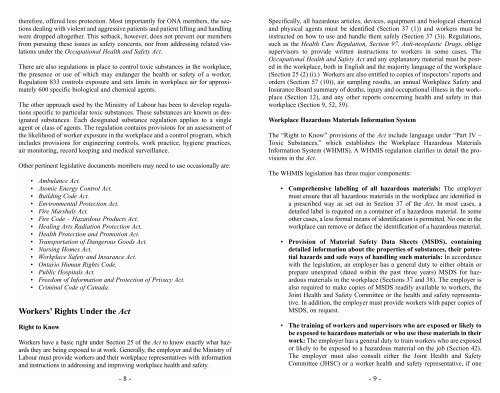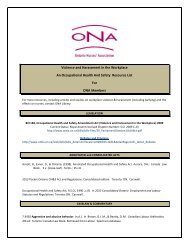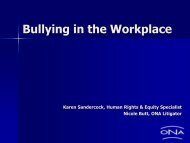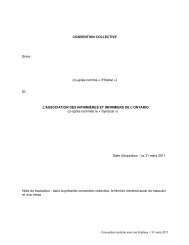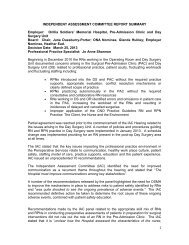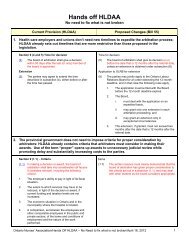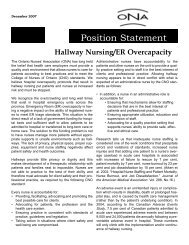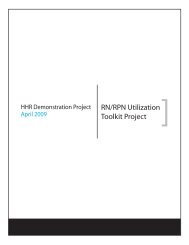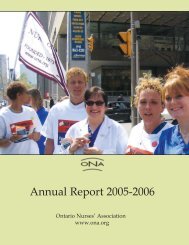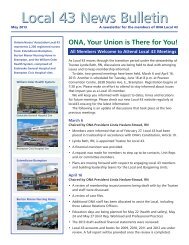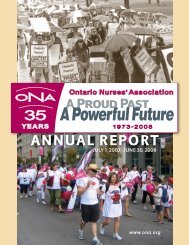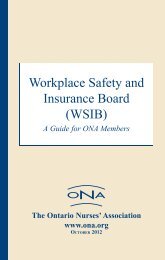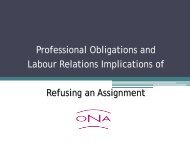Occupational Health & Safety - local70 - Ontario Nurses' Association
Occupational Health & Safety - local70 - Ontario Nurses' Association
Occupational Health & Safety - local70 - Ontario Nurses' Association
You also want an ePaper? Increase the reach of your titles
YUMPU automatically turns print PDFs into web optimized ePapers that Google loves.
therefore, offered less protection. Most importantly for ONA members, the sections<br />
dealing with violent and aggressive patients and patient lifting and handling<br />
were dropped altogether. This setback, however, does not prevent our members<br />
from pursuing these issues as safety concerns, nor from addressing related violations<br />
under the <strong>Occupational</strong> <strong>Health</strong> and <strong>Safety</strong> Act.<br />
There are also regulations in place to control toxic substances in the workplace,<br />
the presence or use of which may endanger the health or safety of a worker.<br />
Regulation 833 controls exposure and sets limits in workplace air for approximately<br />
600 specific biological and chemical agents.<br />
The other approach used by the Ministry of Labour has been to develop regulations<br />
specific to particular toxic substances. These substances are known as designated<br />
substances. Each designated substance regulation applies to a single<br />
agent or class of agents. The regulation contains provisions for an assessment of<br />
the likelihood of worker exposure in the workplace and a control program, which<br />
includes provisions for engineering controls, work practice, hygiene practices,<br />
air monitoring, record keeping and medical surveillance.<br />
Other pertinent legislative documents members may need to use occasionally are:<br />
• Ambulance Act.<br />
• Atomic Energy Control Act.<br />
• Building Code Act.<br />
• Environmental Protection Act.<br />
• Fire Marshals Act.<br />
• Fire Code – Hazardous Products Act.<br />
• Healing Arts Radiation Protection Act.<br />
• <strong>Health</strong> Protection and Promotion Act.<br />
• Transportation of Dangerous Goods Act.<br />
• Nursing Homes Act.<br />
• Workplace <strong>Safety</strong> and Insurance Act.<br />
• <strong>Ontario</strong> Human Rights Code.<br />
• Public Hospitals Act.<br />
• Freedom of Information and Protection of Privacy Act.<br />
• Criminal Code of Canada.<br />
Workers’ Rights Under the Act<br />
Right to Know<br />
Workers have a basic right under Section 25 of the Act to know exactly what hazards<br />
they are being exposed to at work. Generally, the employer and the Ministry of<br />
Labour must provide workers and their workplace representatives with information<br />
and instructions in addressing and improving workplace health and safety.<br />
- 8 -<br />
Specifically, all hazardous articles, devices, equipment and biological chemical<br />
and physical agents must be identified (Section 37 (1)) and workers must be<br />
instructed on how to use and handle them safely (Section 37 (3)). Regulations,<br />
such as the <strong>Health</strong> Care Regulation, Section 97, Anti-neoplastic Drugs, oblige<br />
supervisors to provide written instructions to workers in some cases. The<br />
<strong>Occupational</strong> <strong>Health</strong> and <strong>Safety</strong> Act and any explanatory material must be posted<br />
in the workplace, both in English and the majority language of the workplace<br />
(Section 25 (2) (i).) Workers are also entitled to copies of inspectors’ reports and<br />
orders (Section 57 (10)), air sampling results, an annual Workplace <strong>Safety</strong> and<br />
Insurance Board summary of deaths, injury and occupational illness in the workplace<br />
(Section 12), and any other reports concerning health and safety in that<br />
workplace (Section 9, 52, 59).<br />
Workplace Hazardous Materials Information System<br />
The “Right to Know” provisions of the Act include language under “Part IV –<br />
Toxic Substances,” which establishes the Workplace Hazardous Materials<br />
Information System (WHMIS). A WHMIS regulation clarifies in detail the provisions<br />
in the Act.<br />
The WHMIS legislation has three major components:<br />
• Comprehensive labelling of all hazardous materials: The employer<br />
must ensure that all hazardous materials in the workplace are identified in<br />
a prescribed way as set out in Section 37 of the Act. In most cases, a<br />
detailed label is required on a container of a hazardous material. In some<br />
other cases, a less formal means of identification is permitted. No one in the<br />
workplace can remove or deface the identification of a hazardous material.<br />
• Provision of Material <strong>Safety</strong> Data Sheets (MSDS), containing<br />
detailed information about the properties of substances, their potential<br />
hazards and safe ways of handling such materials: In accordance<br />
with the legislation, an employer has a general duty to either obtain or<br />
prepare unexpired (dated within the past three years) MSDS for hazardous<br />
materials in the workplace (Sections 37 and 38). The employer is<br />
also required to make copies of MSDS readily available to workers, the<br />
Joint <strong>Health</strong> and <strong>Safety</strong> Committee or the health and safety representative.<br />
In addition, the employer must provide workers with paper copies of<br />
MSDS, on request.<br />
• The training of workers and supervisors who are exposed or likely to<br />
be exposed to hazardous materials or who use these materials in their<br />
work: The employer has a general duty to train workers who are exposed<br />
or likely to be exposed to a hazardous material on the job (Section 42).<br />
The employer must also consult either the Joint <strong>Health</strong> and <strong>Safety</strong><br />
Committee (JHSC) or a worker health and safety representative, if one<br />
- 9 -


